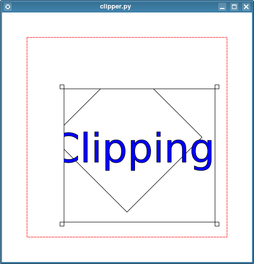Painting and clipping demonstration
This example was created to explore issues with clipping mentioned in this message to the qt-interest mailing list.

The first version (clipper.py) uses QPainter's setClipRect() method to clip painting outside a given rectangle.
1 import sys
2 from PyQt4.QtCore import *
3 from PyQt4.QtGui import *
4
5 class Window(QWidget):
6
7 def __init__(self):
8
9 QWidget.__init__(self)
10 self.largest_rect = QRect(50, 50, 400, 400)
11
12 self.clip_rect = QRect(50, 50, 400, 400)
13 self.dragging = None
14 self.drag_offset = QPoint()
15 self.handle_offsets = (
16 QPoint(8, 8), QPoint(-1, 8), QPoint(8, -1), QPoint(-1, -1)
17 )
18
19 self.path = QPainterPath()
20 self.path.moveTo(100, 250)
21 font = QFont()
22 font.setPixelSize(80)
23 self.path.addText(100, 300, font, "Clipping")
24
25 self.polygon = QPolygon([QPoint(250, 100), QPoint(400, 250),
26 QPoint(250, 400), QPoint(100, 250),
27 QPoint(250, 100)])
28
29 def paintEvent(self, event):
30
31 painter = QPainter()
32 painter.begin(self)
33 painter.fillRect(event.rect(), QBrush(Qt.white))
34 painter.setRenderHint(QPainter.Antialiasing)
35 painter.setPen(QPen(QBrush(Qt.red), 1, Qt.DashLine))
36 painter.drawRect(self.largest_rect)
37 painter.setPen(QPen(Qt.black))
38 painter.drawRect(self.clip_rect)
39 for i in range(4):
40 painter.drawRect(self.corner(i))
41
42 painter.setClipRect(self.clip_rect)
43 painter.drawPolyline(self.polygon)
44 painter.setBrush(QBrush(Qt.blue))
45 painter.drawPath(self.path)
46 painter.end()
47
48 def corner(self, number):
49
50 if number == 0:
51 return QRect(self.clip_rect.topLeft() - self.handle_offsets[0], QSize(8, 8))
52 elif number == 1:
53 return QRect(self.clip_rect.topRight() - self.handle_offsets[1], QSize(8, 8))
54 elif number == 2:
55 return QRect(self.clip_rect.bottomLeft() - self.handle_offsets[2], QSize(8, 8))
56 elif number == 3:
57 return QRect(self.clip_rect.bottomRight() - self.handle_offsets[3], QSize(8, 8))
58
59 def mousePressEvent(self, event):
60
61 for i in range(4):
62 rect = self.corner(i)
63 if rect.contains(event.pos()):
64 self.dragging = i
65 self.drag_offset = rect.topLeft() - event.pos()
66 break
67 else:
68 self.dragging = None
69
70 def mouseMoveEvent(self, event):
71
72 if self.dragging is None:
73 return
74
75 left = self.largest_rect.left()
76 right = self.largest_rect.right()
77 top = self.largest_rect.top()
78 bottom = self.largest_rect.bottom()
79
80 point = event.pos() + self.drag_offset + self.handle_offsets[self.dragging]
81 point.setX(max(left, min(point.x(), right)))
82 point.setY(max(top, min(point.y(), bottom)))
83
84 if self.dragging == 0:
85 self.clip_rect.setTopLeft(point)
86 elif self.dragging == 1:
87 self.clip_rect.setTopRight(point)
88 elif self.dragging == 2:
89 self.clip_rect.setBottomLeft(point)
90 elif self.dragging == 3:
91 self.clip_rect.setBottomRight(point)
92
93 self.update()
94
95 def mouseReleaseEvent(self, event):
96
97 self.dragging = None
98
99 def sizeHint(self):
100 return QSize(500, 500)
101
102
103 if __name__ == "__main__":
104
105 app = QApplication(sys.argv)
106 window = Window()
107 window.show()
108 sys.exit(app.exec_())
The second version (clipper_path.py) shows how the same effect can be achieved by using QPainterPath's intersected() method. Here, we show how the paintEvent() method of the example has been modified:
1 def paintEvent(self, event):
2
3 painter = QPainter()
4 painter.begin(self)
5 painter.fillRect(event.rect(), QBrush(Qt.white))
6 painter.setRenderHint(QPainter.Antialiasing)
7 painter.setPen(QPen(QBrush(Qt.red), 1, Qt.DashLine))
8 painter.drawRect(self.largest_rect)
9 painter.setPen(QPen(Qt.black))
10 painter.drawRect(self.clip_rect)
11 for i in range(4):
12 painter.drawRect(self.corner(i))
13
14 path = QPainterPath()
15 path.addRect(QRectF(self.clip_rect))
16 polygon_path = QPainterPath()
17 polygon_path.addPolygon(QPolygonF(self.polygon))
18 painter.drawPath(path.intersected(polygon_path))
19 painter.setBrush(QBrush(Qt.blue))
20 painter.drawPath(path.intersected(self.path))
21 painter.end()
